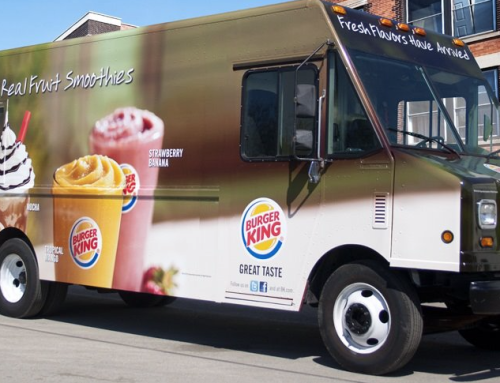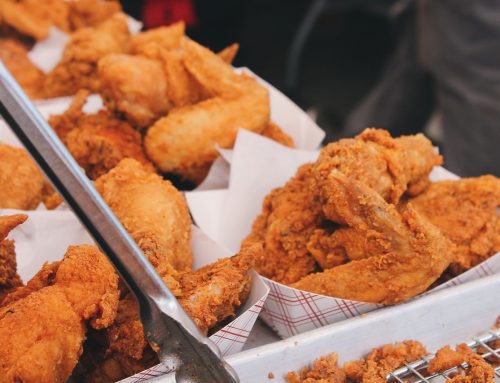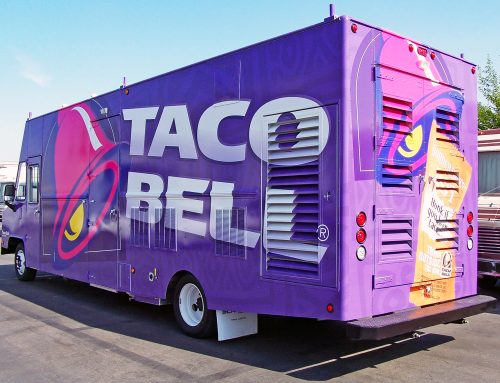Starbucks started with humble beginnings along the cobblestone streets of Pike Place Market, Seattle in 1971. Decades later, this chain grew into the most recognized coffee brand in the world valued at more than $13 billion. But what makes Starbucks customers willing to spend between $3.43 and $7.00 on their favorite drink every day?
To further understand how Starbucks became one of the most powerful coffee chains in history, I evaluate the company’s strengths, weaknesses, opportunities, and threats right here. I also discuss the new discovery that’s expected to bring in another $1 billion in revenue annually.
Starbuck’s SWOT Analysis:
Strengths
Here are some of the strengths of Starbucks.
Cashing in on drink customization – There’s a nearly limitless number of ways you can customize a drink at Starbucks. You could add a shot of espresso. You could opt for almond milk instead of diary. Maybe you like a couple pumps of vanilla inside your Grande cup? Some of these customizations cost extra and add an extra $1 billion in annual revenue for the company according to reports.
Excellent brand image – The coffee chain builds their social initiatives into their brand in part due to their work with the The Starbucks Foundation. The focus areas include bread investment in community, youth, diversity and inclusion.
Starbucks offers a strong benefits package compared to other coffee shops and of course an inclusive work environment that supports a diverse community of barista.
Aside from their physical branding, Starbucks did a great job in positioning itself as a place where people can relax, enjoy their coffee, have a talk with a friend, or simply enjoy a great afternoon. Starbucks is also one of those rare places you can find a bathroom in an urban area. Yet another reason to visit this store.
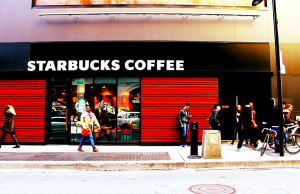
Outside a Starbucks location.
Substantial brand loyalty – Their efforts to better serve their customers go beyond their physical stores. Starbucks’ very own mobile app enables customers to order ahead online, go to a store, get their drink and have a contactless payment. It’s easy-breezy, hassle-free, just like what people want and need nowadays. Focusing on a seamless customer experience allows Starbucks to connect deeper with their customers and maintain the relationship that fuels their market to continuously go back to their brand.
The Starbucks Rewards system is also a powerful concept. In 2021, there were over 24 million active members in the Starbucks Rewards in the US, with 1 million new active Starbucks Rewards members in the 3rd quarter of 2021. I’m happy to say I’m a member myself and love being able to collect stars for free food and drink items.
Rewarding every purchase with points and discounts is an attractive strategy to help people buy more. All in all, the Starbucks app is like a golden ticket for their dedicated fanbase to reward them more as they purchase more. Why would you ever want to visit a coffee shop that doesn’t give you rewards?
Related Reading: DoorDash SWOT Analysis: Can This Delivery App Compete Much Longer?
Worldwide presence and TLOG (transportation, logistics) – With 32,660 stores worldwide, it is safe to say that Starbucks’ worldwide presence is very much felt. Pretty much every country you go to, you can find Starbucks. What’s also great is that aside from offering standardized hot and iced coffee drinks, they offer a unique Starbucks menu depending on which country you’re in. This special menu even inspires people to travel to different countries to make sure they get a taste of those specialty drinks.
With stores in different countries globally, the Starbucks transportation and logistics supply chain helps them find coffee around the world at a very low price. This also makes sure they minimize the amount of transportation cost in each country.
Quality – Any Starbucks fan knows about the Starbucks secret menu which is basically a long list of drink combinations – a total of 87,000 you can try that are not displayed on their official menu. Add this to the 255 items on the usual Starbucks menu and there’s a LOT you can try. Despite its huge list of items, Starbucks focuses on quality drinks. Starbucks offers different learning and development training depending on what level you’re in. This ensures that the quality of products and services is upheld in every Starbucks location.
Along with Starbucks drinks and food, they have merchandise such as mugs, planners, tumblers, and coffee presses. It’s unclear exactly how much revenue this branded merchandise brings in the company annually. But we do know that number is significant.
Weaknesses
With everything going for Starbucks, it can be easy to think the company has everything figured out. But that’s not that case. Every business has exposed flanks that I’ll discuss here.
Price point – Depending on what your order is, a Starbucks drink ranges from $2 to at least $7. After considering all the customizations, the price per drink could get even higher.
Comparing price to competitors like Tim Hortons, McDonald’s, and Dunkin Donuts, Starbucks drinks are more expensive on average. People who drink coffee every day would see that brewing their own cup at home is much cheaper than getting one from Starbucks.
Quality comes with a price so I think that Starbucks might not be able to work on their price point anytime soon as it is part of the branding image they’ve built through the years as a company that serves quality coffee. Also, considering wage and coffee inflation it will be difficult for any coffee chain to cut costs.
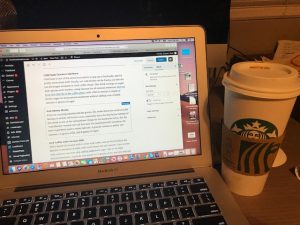
My writing a blog post and drinking a Venti dark roast.
Food Diversification and Growth – Unlike McDonald’s where you can buy coffee and order a hash brown, a muffin, or a whole list of breakfast choices, at Starbucks there are less food options. But Starbucks has been gradually increasing food sales each year. For example in 2011, the company generated just over $2 billion in food sales. Fast forward to 2021 and Starbucks sold more than $5 billion of food. But how much farther can Starbucks grow this segment? The future is still unclear.
Related Reading: How Much Does it Cost to Open a Starbucks Franchise?
Starbucks recalls – Like any brand or business, reputation is vital and product recall can hurt the image. In 2019 though, it was reported that they had to recall their Bodum Recycled Coffee Presses due to laceration hazard. Product recalls can damage a brand’s reputation especially for Starbucks that upholds great quality products and services. Starbucks should work on maintaining the consistency of their products, not just their food and beverages but also their merchandise.
High-calorie products – Many Starbucks drinks are high in calories making them very unhealthy when consumed frequently. While customers can opt for fewer additives, the outcome might not be as well-liked since Starbucks has built its reputation on sweetened products.
The continuous trend of healthy eating through the years can hinder Starbucks to attract more customers unless they create healthier choices or provide modifications for their existing menu to cater to health-conscious consumers, especially when it comes to the food menu.
Opportunities
A successful company like Starbucks still has plenty of opportunities ahead of them to grow and improve the business.
Corporate social responsibility – Using their brand image, Starbucks has always been at the forefront of maintaining their corporate social responsibility by committing to be transparent and reporting regularly about their efforts to improve economic conditions for coffee farmers, minimize their environmental footprint, and make positive contributions to the communities they serve around the world.
By continuing to engage in social issues and actions, they can maintain and further develop a positive brand image in the eyes of their partners, customers, and stakeholders.
Specialty drinks – The Starbucks specialty drinks are already popular but what the company can do to leverage its popularity and create more buzz is by collaborating with influencers or celebrities and making specialty drinks based on them. This shows the effort of working with others to better serve their market and tapping into influencers and celebrities creates a good impression for the brand as well.
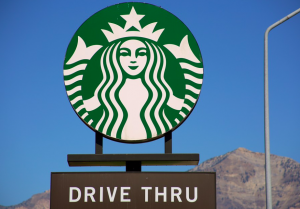
Do you ever visit the Starbucks drive thru?
Delivery – In the height of the pandemic, many businesses grappled as they try their best to survive and adjust to the struggles and difficulties faced by restrictions and continuous lockdowns worldwide. One thing to help Starbucks stay consistent with their sales is by developing delivery menus and offerings. Initially, Starbucks has partnered with delivery giant Uber Eats to cover more cities in the US.
I think it’s time for Starbucks to have their own delivery service to better serve their customers especially since the global online food delivery revenue is expected to reach almost $2 billion in the next three years.
Emerging markets – With a very strong foothold in the US and continuous growth in China, Starbucks can leverage on their success in these countries and capitalize in deep market research especially in places without Starbucks, to use their brand and enter a new market. Doing this would even move Starbucks further and solidify itself as a leading coffee brand in the industry.
Threats
Threats can be defined as anything that can negatively affect a business as established as Starbucks. These factors can be unexpected like a pandemic or global challenges.
Pandemic – The health crisis threatened both large and small businesses around the world. Statistics show that more than 110,000 eating and drinking establishments have closed in 2020 and restaurant sales across the country were down $240 billion in the same year.
In international markets like China, Starbucks could be at risk of temporarily closing down locations due to government demands. This is an ongoing risk considering Starbucks is relying on China for future growth and expansion.
Competitors selling similar products – Having so many competitors selling the same product (coffee) can lead to market saturation. The rise of small, locally-owned coffee shops in different countries worldwide can become a regional threat to Starbucks.
Related Reading: 201+ All-Time Best Starbucks Captions for Instagram
These small artisan coffee shops offer high-quality products that can arguably surpass what Starbucks offers. And maybe because of its size, it gives customers a more hands-on feel into their marketing and sales effort, giving them a sense of being part of the community and helping a small, growing business.
According to PRNewswire, the global specialty coffee shops market is expected to grow by over $80 billion in 2024.
Economy – Not everyone can afford to buy coffee every day at a coffee shop. And if the global economy struggles, Starbucks could see a decline in sales. World Bank forecasts that there will be a slow global growth through 2023. In these struggling times, how people act to survive a declining economy can go from giving up small luxuries like drinking Starbucks coffee.
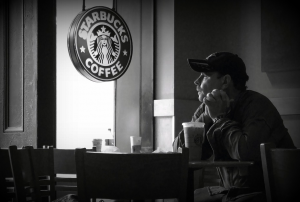
Looking out the window of a Starbucks coffee shop.
Starbucks, despite how big it is, goes through similar struggles of eating and drinking establishments worldwide as we all go through the pandemic, global recession, and many other factors that affect the food industry’s growth.
But what makes Starbucks different from others is its proven capability to overcome these struggles time and time again. Thanks to its solid base of loyal customers, global brand recognition, and well-thought-out marketing plan, I expect this company will continue to be a staple brand in the United States for decades to come.
From opening one store to having around 32,000 stores worldwide, it may seem like a Cinderella run but what has truly made Starbucks the brand we know today is their outstanding strategy and vision to serve the industry.
Do you visit and support your local Starbucks? Let me know how you feel about the brand on social media.

